Hawks Nest State Park
Introduction
Text-to-speech Audio
Images
The state historical marker erected in 1937, as Governor Homer Holt took office. Holt was determined to minimize public knowledge of Union Carbide's negligence toward the safety of the Hawks Nest Tunnel workers. Located at the Overlook.
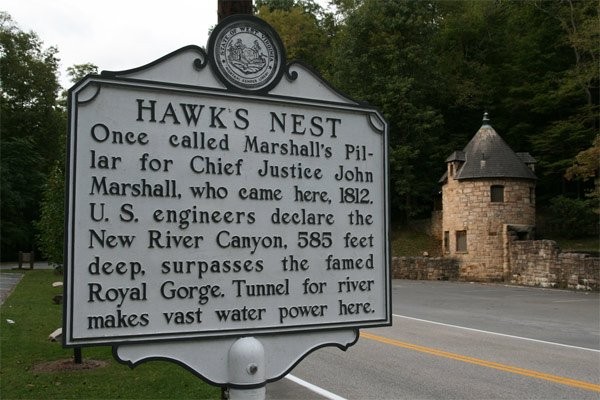
The aerial gondolas in the park. The aerial tramway was built in 1970 and provides visitors a dramatic view down the mountain to the river, where jet boat rides are also available.
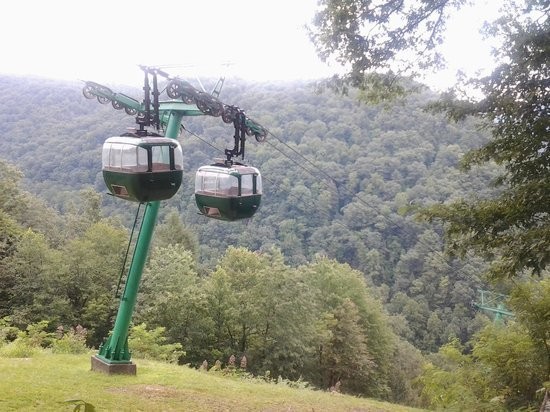
The museum built by the Civilian Conservation Corps during the 1930s.
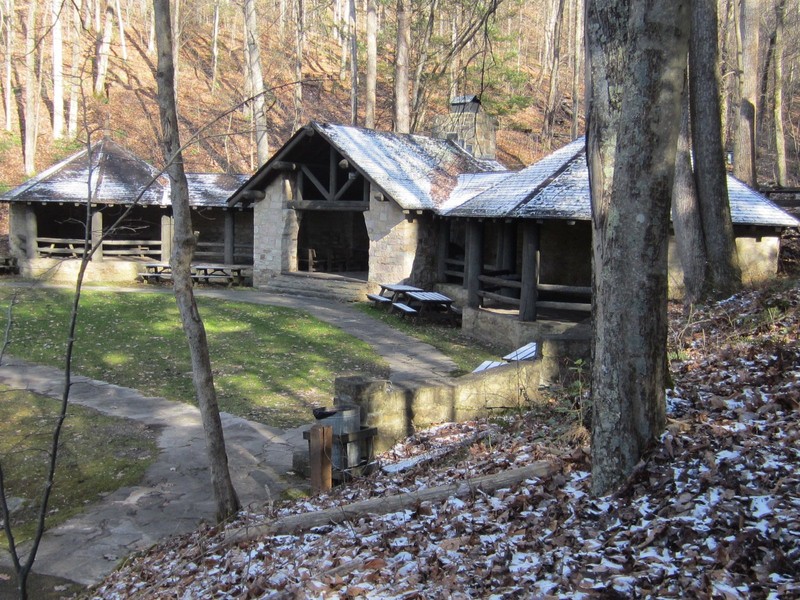
The round stone bathroom built by the Civilian Conversation Corps.
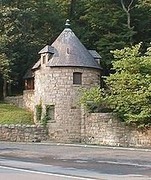
The overlook built by the Civilian Conservation Corps.
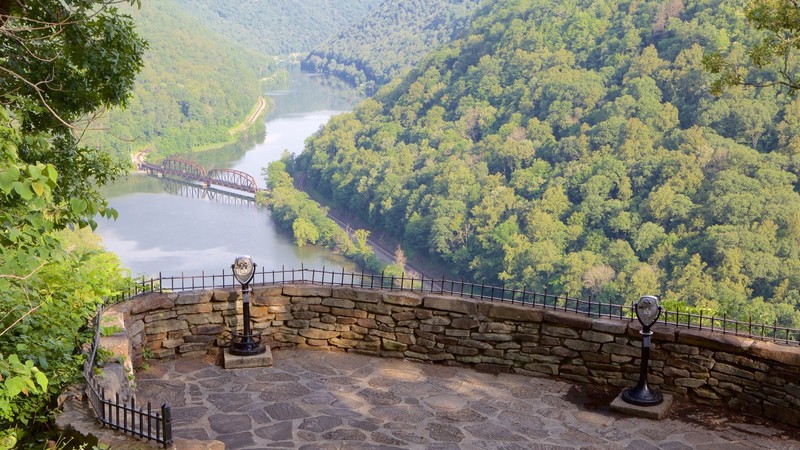
Hawks Nest Lodge. The boxy style of the building is typical of architect Walter Gropius's modern architecture.
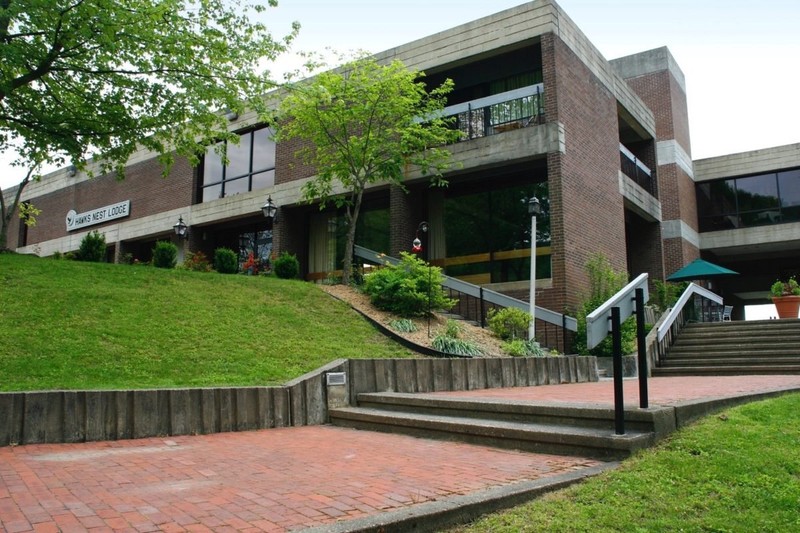
Postcard depicting the Grille and picnic shelters circa 1930-45.
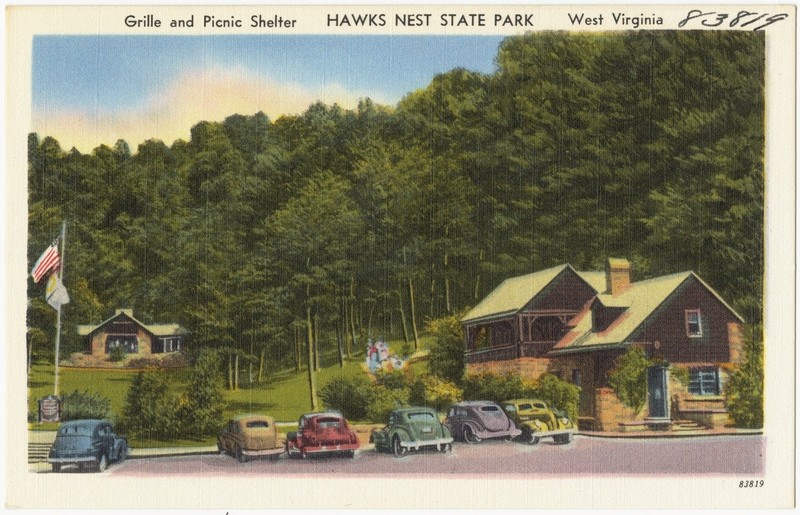
Postcard showing the beautiful horseshoe bend of the New River circa 1930-45.
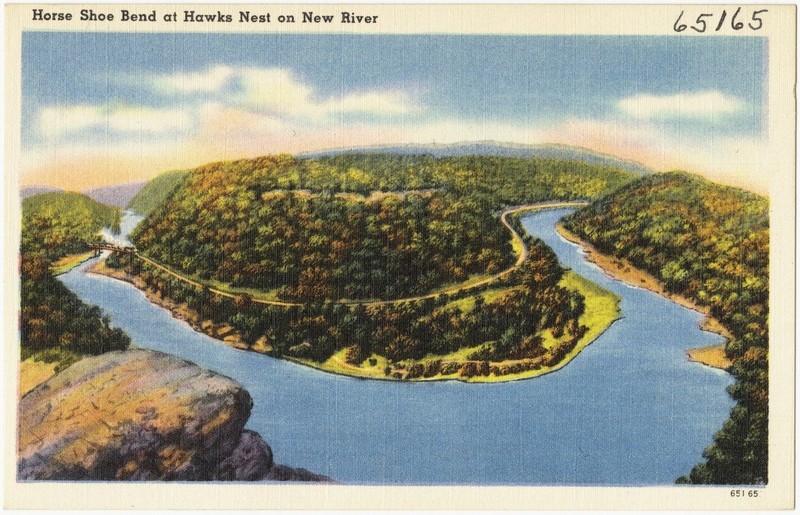
1862 print showing the view from Hawks Nest towards the East. Union troops had an outpost in the area at the time, which was hastily evacuated during the Confederate invasion in August of that year.
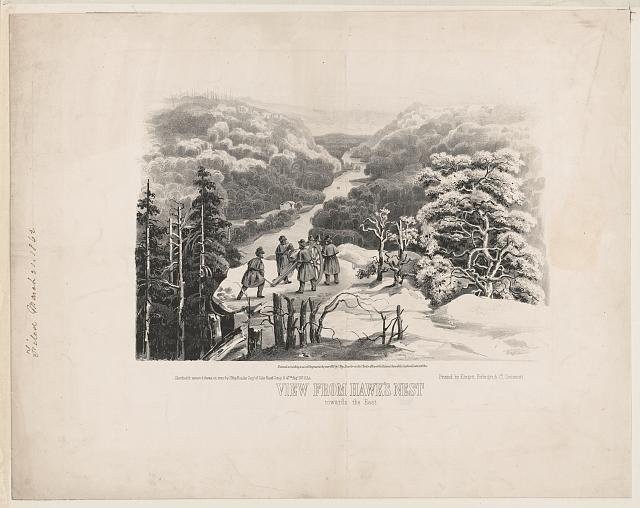
1862 print showing the view from Hawks Nest towards the West. Though Union troops abandoned the post during the Confederate invasion that took Charleston, the Federals were back in possession by the end of the year.
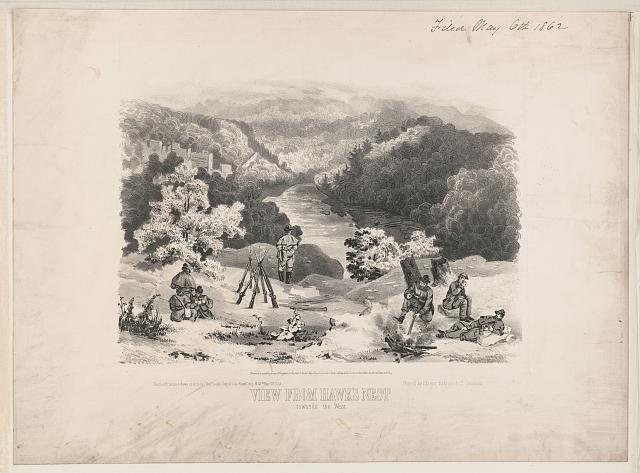
WV Historical Marker--located near the Park Lodge
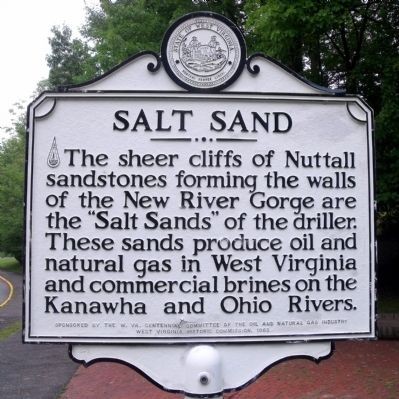
Backstory and Context
Text-to-speech Audio
Chief Justice John Marshall visited this region along the Kanawha River in the early 1800s, and was so impressed by the views that the area became known as “Marshall’s Pillars.” By the time the Civil War broke out, the area was simply known as Hawks Nest Rock--so named for the ospreys, often referred to as fish hawks, that frequent the area. The Gauley River was an important transportation route during the Civil War and skirmishes broke out in the area for control of this vital supply line. Confederate General (and former Virginia governor) Henry Wise established camps on the nearby heights, which provided good views for pickets of any approaching enemies. Later, Union troops consolidated control over the area and pushed out the Confederates. Their camp nearby was the sometime home of future president Rutherford B. Hayes and the 23rd Ohio Infantry.
On March 30, 1930, a contract was awarded to Rinehart and Dennis Corporation of Charlottesville, Virginia to build the tunnel and dam nearby. They had exactly two years from that date to get it finished. The tunnel, three miles long, would divert water through Gauley Mountain and supply power to the new metallurgic plant then being built in Alloy. It was drilled directly through high grade silica rock. With such a short window in which to complete the project, Rinehart and Dennis often ignored safety protocols and took shortcuts, resulting in a lack of safety equipment for the workers. And workers were not in short supply: even as many fell ill from the copious dust in the mine, more stepped forward to take their place, as the Great Depression had deprived many American men of employment.
Using a dry drilling technique instead of wetting down the rock to reduce dust--a technique already well-known at the time-- produced such large amounts of silica dust that many miners were too ill to work within fifteen weeks of starting. A Congressional hearing eventually attributed 476 deaths. A study published by epidemiologist Martin Cherniack in 1986 estimates the total to be 764.
In 1935, the state of West Virginia bought the land around the dam and the tunnel to build a state park. The area includes cliffs, streams, and a lake. The lake was formed by the damming of the river in 1934. The Civilian Conservation Corps (CCC) performed the work of transforming the area near Gauley Bridge, blighted for years by the Tunnel tragedy, into a State Park. The CCC was considered one of Franklin Roosevelt’s greatest New Deal programs, often shaping national and state parks programs in ways that survive to this day. For example, the CCC planted more than 3 billion trees and constructed trails and shelters in more than 800 parks across the country. The CCC built several of the stone buildings featured in the park. The park museum, main overlook visitor complex, picnic shelters, and even the unique round tower shaped restrooms were built by CCC workers. The museum has a glassed observation room that offers a view of the gorge.
In 1939, after the park had been completed, it was included in a state guide written by the Works Progress Administration--which, as part of President Roosevelt’s New Deal employment relief programs, was writing visitors’ guides for all (then) forty-eight states. Called West Virginia: Guide to the Mountain State, its publication was held up by then-Governor Homer Holt, who insisted that it was “propaganda” for its frank admission of labor troubles during the Miner’s March of 1921 and the Hawks Nest Tunnel tragedy. Holt had been the state’s Attorney General during the Hawks Nest affair, and had stalwartly backed Union Carbide throughout the proceedings. He later served as a lawyer for Union Carbide after his governorship. Holt’s battle with the WPA lasted his entire tenure in office and nearly killed federal funding for the guide; finally, the WPA was able to publish the book intact after Governor M.M. Neely was elected in 1941.
The Department of Natural Resources took control of the property in 1963. A four-story lodge was built shortly after, designed by Walter Gropius’ architectural firm. Gropius was a world-renowned architect whose works remain influential to this day. He also designed, among many other structures, the Huntington Museum of Art and John F. Kennedy Federal Office Building in Boston. The lodge contains 31 rooms while the restaurant features a wide, two-story window wall that faces the gorge.
The park features seven different hiking trails of varying distance and difficulty. A golf course within the park began operation in 1999 until a budget deficit resulted in its closure in 2013. The park’s famous views and rich history, along with its close proximity to the perennially popular New River Gorge, draws thousands of visitors annually.
Cite This Entry
Warmack, Kyle, Stephanie Fragale on behalf of South Charleston Interpretive Center, and Kathleen Thompson. "Hawks Nest State Park." Clio: Your Guide to History. September 21, 2020. Accessed April 28, 2025. https://theclio.com/tour/1596/39
Sources
National Park Service. Hawks Nest Tunnel Disaster. February 18, 2018. Accessed April 28, 2018. https://www.nps.gov/neri/planyourvisit/the-hawks-nest-tunnel-disaster-summersville-wv.htm.
Crockett, Maureen F.. Hawks Nest State Park. E-WV. February 21, 2012. Accessed April 20, 2018. https://www.wvencyclopedia.org/articles/332.
Moore, C. V.. Leaders Hope to Keep Hawks Nest Golf Course Open. The Register Herald. June 09, 2013. Accessed April 19, 2018. http://www.montgomery-herald.com/news/local_news/leaders-hope-to-keep-hawks-nest-golf-course-open/article_ebe7abe6-1bc2-582c-8e64-067cd0681500.html.
Archives, West Virginia State. Homer Adams Holt. . Accessed April 30, 2018. http://www.wvculture.org/history/government/governors/homeholt.html.
"Salt Sand." The Historical Marker Database. Accessed September 21, 2020. https://www.hmdb.org/m.asp?m=34420.

